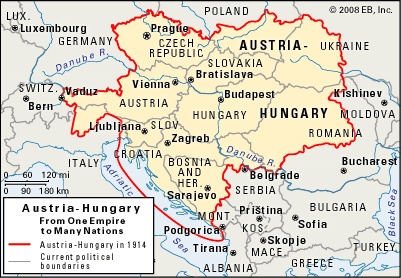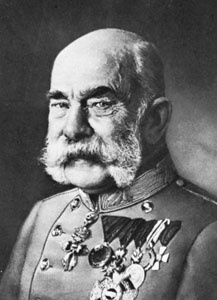Austria-Hungary
historical empire, Europe
also called Austro-Hungarian Empire, or Austro-Hungarian Monarchy, byname Dual Monarchy, German Österreich-ungarn, Österreichisch-ungarisches Reich, or Österreichisch-Ungarische Monarchie, or Doppelmonarchie
 the Habsburg (Habsburg, House of) empire from the constitutional Compromise (Ausgleich) of 1867 between Austria and Hungary until the empire's collapse in 1918.
the Habsburg (Habsburg, House of) empire from the constitutional Compromise (Ausgleich) of 1867 between Austria and Hungary until the empire's collapse in 1918.A brief treatment of the history of Austria-Hungary follows. For full treatment, see Austria: Austria-Hungary, 1867–1918 (Austria).
The empire of Austria, as an official designation of the territories ruled by the Habsburg monarchy, dates to 1804, when Francis II, the last of the Holy Roman emperors, proclaimed himself emperor of Austria as Francis I. Two years later the Holy Roman Empire came to an end. After the fall of Napoleon (1814–15), Austria became once more the leader of the German states; but the Austro-Prussian War of 1866 resulted in the expulsion of Austria from the German Confederation and caused Emperor Francis Joseph to reorient his policy toward the east and to consolidate his heterogeneous empire. Even before the war the necessity of coming to terms with the rebellious Hungarians had been recognized. The outcome of negotiations was the Ausgleich concluded on Feb. 8, 1867.
 The agreement was a compromise between the emperor and Hungary, not between Hungary and the rest of the empire. Indeed the peoples of the empire were not consulted, despite Francis Joseph's earlier promise not to make further constitutional changes without the advice of the imperial parliament, the Reichsrat. Hungary received full internal autonomy, together with a responsible ministry, and, in return, agreed that the empire should still be a single great state for purposes of war and foreign affairs. Francis Joseph thus surrendered his domestic prerogatives in Hungary, including his protection of the non-Magyar peoples, in exchange for the maintenance of dynastic prestige abroad. The “common monarchy” consisted of the emperor and his court, the minister for foreign affairs, and the minister of war. There was no common prime minister (other than Francis Joseph himself) and no common cabinet. The common affairs were to be considered at the delegations, composed of representatives from the two parliaments. There was to be a customs union and a sharing of accounts, which was to be revised every 10 years. This decennial revision gave the Hungarians recurring opportunity to levy blackmail on the rest of the empire.
The agreement was a compromise between the emperor and Hungary, not between Hungary and the rest of the empire. Indeed the peoples of the empire were not consulted, despite Francis Joseph's earlier promise not to make further constitutional changes without the advice of the imperial parliament, the Reichsrat. Hungary received full internal autonomy, together with a responsible ministry, and, in return, agreed that the empire should still be a single great state for purposes of war and foreign affairs. Francis Joseph thus surrendered his domestic prerogatives in Hungary, including his protection of the non-Magyar peoples, in exchange for the maintenance of dynastic prestige abroad. The “common monarchy” consisted of the emperor and his court, the minister for foreign affairs, and the minister of war. There was no common prime minister (other than Francis Joseph himself) and no common cabinet. The common affairs were to be considered at the delegations, composed of representatives from the two parliaments. There was to be a customs union and a sharing of accounts, which was to be revised every 10 years. This decennial revision gave the Hungarians recurring opportunity to levy blackmail on the rest of the empire.The Ausgleich came into force when passed as a constitutional law by the Hungarian parliament in March 1867. The Reichsrat was only permitted to confirm the Ausgleich without amending it. In return for this the German liberals, who composed its majority, received certain concessions: the rights of the individual were secured and a genuinely impartial judiciary was created; freedom of belief and of education were guaranteed. The ministers, however, were still responsible to the emperor, not to a majority of the Reichsrat.
The official name of the state shaped by the Ausgleich was Austria-Hungary. The kingdom of Hungary had a name, a king, and a history of its own. The rest of the empire was a casual agglomeration without even a clear description. Technically it was known as “the kingdoms and lands represented in the Reichsrat” or, more shortly, as “the other Imperial half.” The mistaken practice soon grew of describing this nameless unit as “Austria” or “Austria proper” or “the lesser Austria”—names all strictly incorrect until the title “empire of Austria” was restricted to “the other Imperial half” in 1915. These confusions had a simple cause: the empire of Austria with its various fragments was the dynastic possession of the House of Habsburg, not a state with any common consciousness or purpose.
- Resheph
- Reshevsky, Samuel Herman
- Resia Pass
- residence
- residencia
- residual landform
- resin
- resistance
- Resistencia
- resistivity
- resistor
- resist printing
- res judicata
- Resnais, Alain
- resolution
- resonance
- resonance, theory of
- resonator
- resorcinol
- Respighi, Ottorino
- respiration
- respiration, human
- respiratory disease
- respiratory distress syndrome of newborns
- respiratory therapy